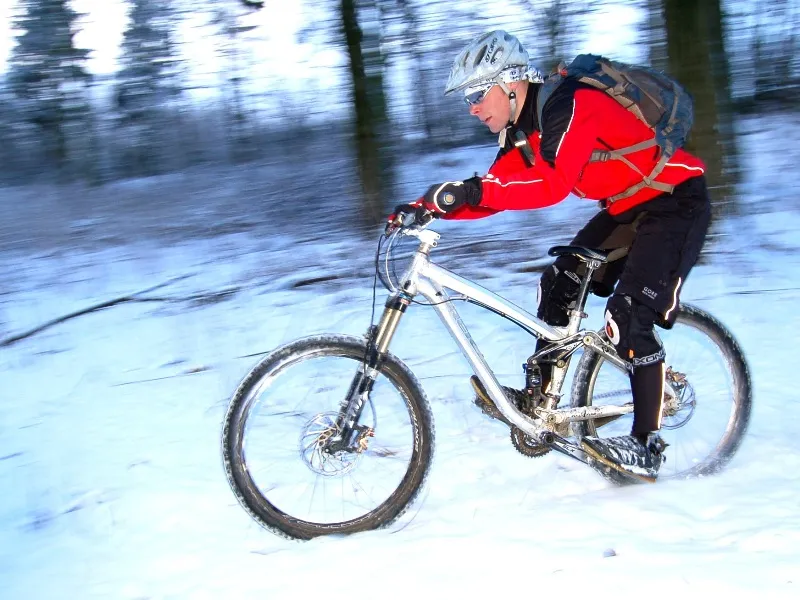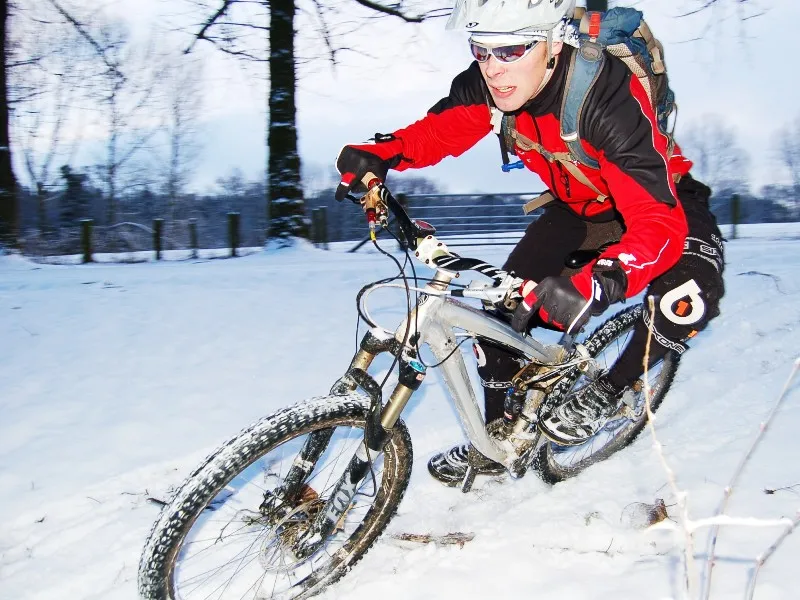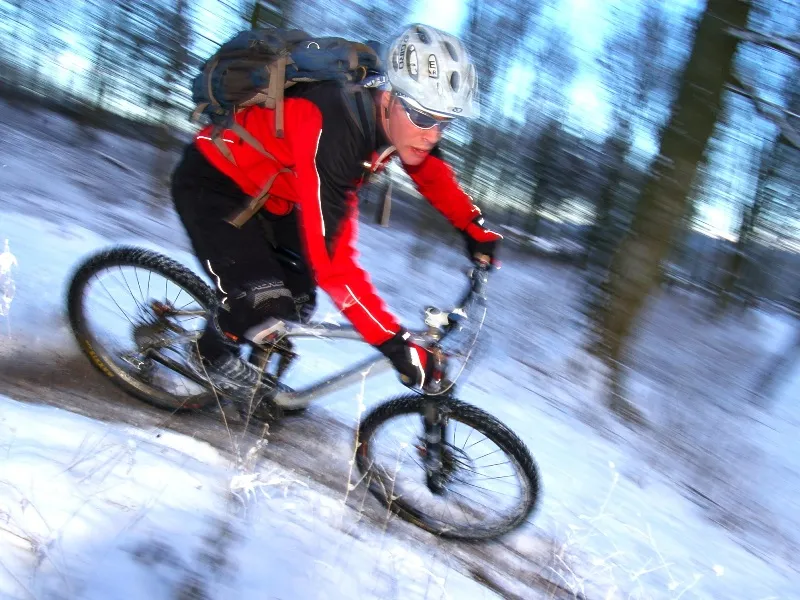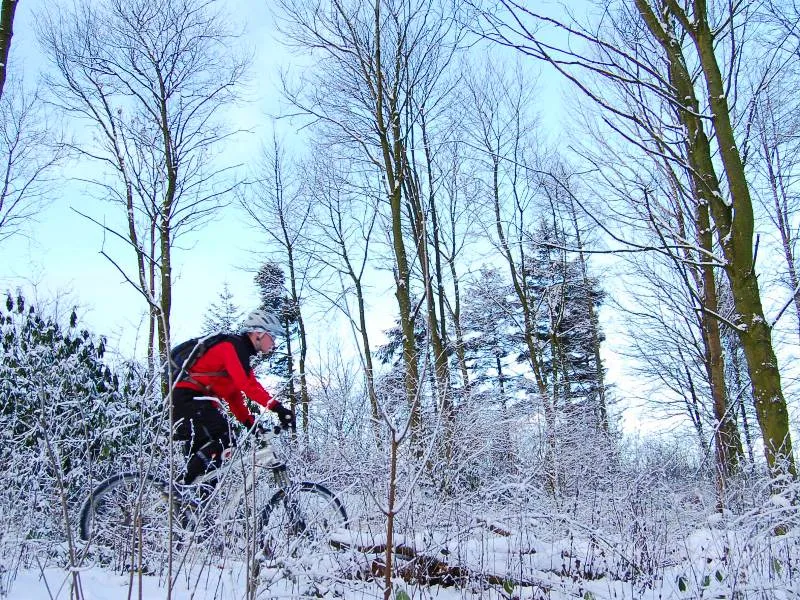We’ve been snowed under (groan) with requests for advice about riding in the white stuff, so Chris Ford of CycleActive, our skills Q&A expert, has kitted up and ridden out in sub-zero temperatures to bring you this guide.
Based in England's Lake District, the CycleActive coaching team are no strangers to riding in snow and ice. They say the secret is to stay light on your bike, be ready for the unpredictable and react quickly to stay in control. Here's some practical advice on how to turn these ideas into a riding reality.
Straight line speed
When you descend in snow you need to be sure your front wheel flies smoothly over the trail, and never digs in or stalls. You also need to know that if the front wheel does drop away from you suddenly it won’t pull you forwards.
To make this work in practice you need to stay low on the bike – far lower than you would normally for even a gentle slope – and ensure that you’re riding with your hips behind the saddle and your heels down.
Being low gives you a lot of flex in your elbows, so if the front wheel dives you can hold your body position and just let your arms extend. This avoids putting more weight forwards onto the wheel as it goes. With hips back and heels down you can push forwards through your feet and the bottom bracket to generate lift and keep things moving if the front wheel starts to dip.

Vision is also incredibly important in the snow and ice. Look as far ahead as you can down the trail – scanning forwards for anything jutting out or any well worn icy patches where riders have gone before. Sometimes a well worn grove is a real bonus, but it can become a slippery trench so use virgin powder on the edge of trails for grip and deceleration if you need it.
Turning at speed
Attacking a turn in the snow may not seem like a smart thing to do, but if you get it right it can be fast, exhilarating and leave other riders far behind. The key is to accentuate everything you do in a normal high-speed turn.
Get lower over the bike so you can absorb unpredictable bumps through the increased flex in arms and legs; drop the outside foot but still with flex in that outside knee, and point your inside knee right into the apex of the turn; look as far round the turn as possible for maximum planning time; crank the bike right over onto the big, grippy knobs that run down the side of the tyres.

Leaning the bike into a snowy turn is really important if you are travelling fast. Even if the tyres slip out for a second they push a small bank of snow up behind them which can act as a kind of self-styled berm. Practise throwing the bike into a hard turn on a bit of flat ground or a gentle slope covered in snow and feel the bite of the tyres in the powder – it can be surprisingly grippy.
Skid turns and singletrack
Of course, sometimes you don’t want too much grip in a turn. If you’re coming into a tight corner and there’s not much traction then you can slam on the back brakes, flick your hips as you lay over the bike and drive the back wheel out through the snow and slush.
You’ll see downhillers doing this in the dust of midsummer and it’s the same technique – you just need to get used to the feeling of letting the back wheel break out . It helps if you stay low and loose, but centred over the bike as you lean it hard into the turn.

If you’re riding fast on singletrack and the turns are coming at you quickly, you won’t have time to drop your outside foot. In this case just keep the cranks level, heels down in case you need to pump forwards for lift, and keep your knees wide and “baggy”.
This position lets you lean the bike quickly from side to side for the turns, keeping your body central over it as you go from edge to edge like a slalom skier.
Journeys in the snow
At CycleActive we run leadership courses for the SMBLA (Scottish Mountain Bike Leaders Association) and one of the big issues we have to address is how to stay safe with a group, or on your own, in all conditions. This feature covers some skills that are great fun and can be applied on all kinds of trails, but it doesn’t mean we want you to throw caution to the wind as you head out into the snow.

If you have local trails where you can work on snow cornering skills as part of a fast blast then get out and try it. See how far you can push the wheels out with a flick of the hips or a push through your outside foot. But don’t practise at the furthest corner of a big journey in The Lakes or the Peak District, for example.
Finally, if you’re getting kitted up for winter riding, be sure to carry a blizzard survival jacket or a small group shelter – both cost about £30 and will genuinely keep you warm if you need to use them.
Also, be sure to wear a couple of Buff-type scarfs around your neck to keep the warm air inside your jacket, and check the weather carefully – not just temperatures but also wind direction and strength. Sub-zero conditions make for amazing biking but need to be treated with caution.